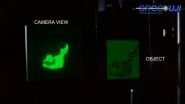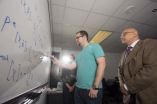(Press-News.org) NASA's Aqua satellite captured a picture of Tropical Storm Douglas as it began moving into cooler waters in the Eastern Pacific Ocean. Those cooler waters, coupled with drier air are expected to bring about the storm's demise, according to the National Hurricane Center.
A visible image of Tropical Storm Douglas was taken by the Moderate Resolution Imaging Spectroradiometer or MODIS instrument aboard NASA's Aqua satellite on July 1 at 21:20 UTC (5:20 p.m. EDT). The thickest band of thunderstorms appeared over the southern semi-circle of the weakening storm while bands of thunderstorms in the northwestern quadrant appeared thinner.
At 5 a.m. EDT on July 2, satellite data showed a burst of deep convection (rising air that forms thunderstorms that make up a tropical cyclone) in the northern semicircle of Tropical Storm Douglas, despite being over cooler waters. Sea surface temperatures generally need to be around 80F (26.6C) to maintain thunderstorm development in a tropical cyclone. Douglas has now entered cooler waters.
On July 2 at 5 a.m. EDT (09:00 UTC) the center of Tropical Storm Douglas was located near latitude 19.6 north and longitude 116.0 west, about 455 miles (730 km) west-southwest of the southern tip of Baja California, Mexico. Douglas is moving toward the northwest near 3 mph (6 kph) and a slow motion toward the northwest or north-northwest is expected for the next couple of days as the storm weakens. Maximum sustained winds are near 45 mph (75 kph).
Forecaster Stewart at the National Hurricane Center noted today that the water ahead Douglas will become increasingly colder while the surrounding air mass will become drier and more stable, sapping the ability for thunderstorm development. NHC expects gradual weakening over the next day and Douglas is expected to become a remnant low by 48 hours, if not sooner.
INFORMATION:
NASA sees a weaker Tropical Storm Douglas
2014-07-02
ELSE PRESS RELEASES FROM THIS DATE:
Squid sucker ring teeth material could aid reconstructive surgery, serve as eco-packaging
2014-07-02
Squid tentacles are loaded with hundreds of suction cups, or suckers, and each sucker has a ring of razor-sharp "teeth" that help these mighty predators latch onto and take down prey. In a study published in the journal ACS Nano, researchers report that the proteins in these teeth could form the basis for a new generation of strong, but malleable, materials that could someday be used for reconstructive surgery, eco-friendly packaging and many other applications.
Ali Miserez and colleagues explain that in previous research, they discovered that sharp, tough squid sucker ...
'Green buildings' have potential to improve health of low-income housing residents
2014-07-02
The "green building" trend is often associated with helping the environment by using eco-friendly materials and energy-saving techniques, but these practices are designed to improve people's health, too. Now scientists are reporting evidence that they can indeed help people feel better, including those living in low-income housing. Published in ACS' journal Environmental Science & Technology, the study found that certain health problems of public housing residents who moved into green buildings noticeably improved.
Gary Adamkiewicz, Meryl Colton and colleagues note that ...
Toward a new way to keep electronics from overheating
2014-07-02
Computer technology has transformed the way we live, but as consumers expect ever more from their devices at faster speeds, personal computers as well as larger electronic systems can overheat. This can cause them to slow down, or worse, completely shut down. Now researchers are reporting in the ACS journal Industrial & Engineering Chemistry Research that liquids containing nanoparticles could help devices stay cool and keep them running.
Rahman Saidur and colleagues point out that consumers demand a lot out of their gadgets. But that puts a huge strain on the tiny parts ...
Overcoming light scattering: New optical system sees deeper inside tissue
2014-07-02
VIDEO:
After the diffuser, the information content of the object is scrambled so that the light distribution at the pixelated sensor looks like the familiar speckle noise.
Click here for more information.
Optical imaging methods are rapidly becoming essential tools in biomedical science because they're noninvasive, fast, cost-efficient and pose no health risks since they don't use ionizing radiation. These methods could become even more valuable if researchers could find a way ...
Becoming an expert takes more than practice
2014-07-02
Deliberate practice may not have nearly as much influence in building expertise as we thought, according to research published in Psychological Science, a journal of the Association for Psychological Science.
Scientists have been studying and debating whether experts are "born" or "made" since the mid-1800s. In recent years, deliberate practice has received considerable attention in these debates, while innate ability has been pushed to the side, due in part to the famous "10,000-hour rule" coined by Malcolm Gladwell in his 2008 book Outliers.
The new study, from psychological ...
Joslin scientists identify process that affects fat distribution and metabolic syndrome
2014-07-02
BOSTON – July 1, 2014 – Building upon their earlier research on the biology of fat metabolism, Joslin scientists discovered that microRNAs –small RNA molecules that play important roles in regulation in many types of tissue – play a major role in the distribution and determination of fat cells and whole body metabolism. Also, the study is the first to reveal that microRNAs (miRNAs) influence the development of lipodystrophy (abnormal fat accumulation) which affects many people with HIV receiving anti-retroviral therapy. The findings appear in the August issue of the Journal ...
UH researchers identify one of world's thinnest piezoelectric materials
2014-07-02
HOUSTON, July 1, 2014 – There are a handful of naturally occurring materials, known as piezoelectric materials, that generate electricity if you bend, stretch or apply another mechanical force to them, and vice versa – if you apply a voltage across them, they'll deform accordingly. These materials are currently the subject of intense research for their potential applications in energy harvesting, artificial muscles and sensors, among others. These materials are also used in everyday devices, such as loudspeakers, which rely on piezoelectrics to convert electrical signals ...
3D printer to aid the visually impaired students in their educational endeavors
2014-07-02
Braille is a tactile writing system, which is commonly used by the visually impaired and partially sighted. With the recent development of braille printers, written materials in braille has greatly helped the visually impaired and partially sighted individuals but, this is not to say that there are still many remaining problems such as books that are immobile due to their size and volume as well as durability. Moreover, there are other problems such as not enough books, materials, works, and data for such individuals.
New technology has been developed to make tactile ...
Comedy, the refuge of gays in Franco-era cinema
2014-07-02
This news release is available in Spanish.
This research studies the presence and visibility of the gay world in Spanish cinema between 1940 and 1975. The report, published in the journal Zer by Alejandro Melero, professor in the UC3M Department of Journalism and Audiovisual Communication, shows that there were genres that homosexuality appeared in more frequently. One such genre is comedy, in which it was very usual to portray gays as funny characters.
Beyond our borders—and in sharp contrast to Spanish cinema—directors like Alfred Hitchcock were forerunners in ...
Research could lead to dramatic energy savings at data farms
2014-07-02
PULLMAN, Wash. - Washington State University has developed a wireless network on a computer chip that could reduce energy consumption at huge data farms by as much as 20 percent.
Researchers led by Partha Pande, a computer engineering professor in the School of Electrical Engineering and Computer Science, have filed two patents on their wireless multicore chip design, which could also speed up data processing. The team, which includes associate professors Deukhyoun Heo and Benjamin Belzer, has a paper on their work in the May issue of ACM Journal on Emerging Technologies ...




